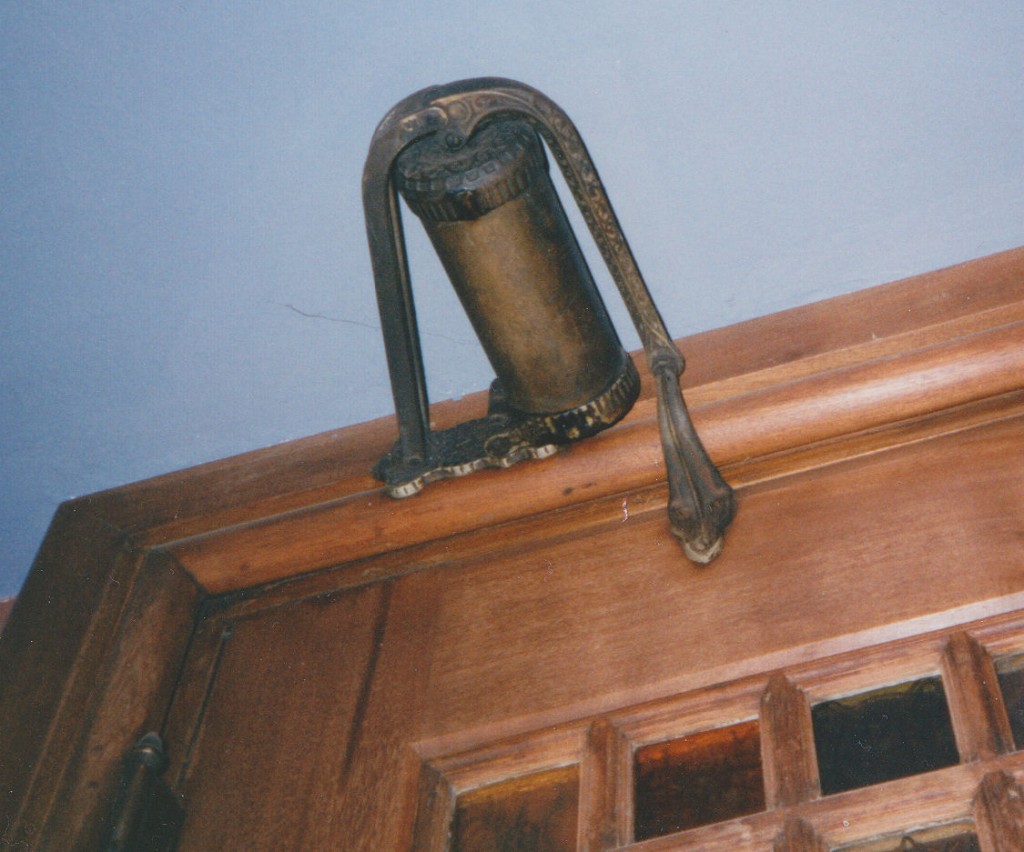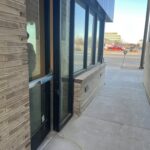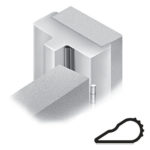I was recently cleaning out a drawer and found copies of a 3-part article printed in Doors & Hardware in 1986. The articles were written in 1937. I thought I should preserve this piece of our history, so here is the first installment (others to follow).
A Memoir from 1880 – How I Discovered Door Checks
by L.C. Norton, Inventor of Door Checks
 We hope you enjoy this fascinating history of the development of the door closer as told by L.C. Norton, “Inventor of Door Checks.”
We hope you enjoy this fascinating history of the development of the door closer as told by L.C. Norton, “Inventor of Door Checks.”
I have been asked by the President of the Norton-Lasier Co. of Chicago, Mr. D.R. Lasier, to write up a little history of the Door Check or Door Closer business from the time it started in 1880 to the present time, 1937.
Up to the year 1880, so far as I know, there was no device to control the opening and closing of doors. There were springs and weights to close doors, but they were closed with a bang and it was hard on the nerves to stand the noise.
Having left the farm at the age of 18 to learn the building trades instead of taking a college training (this was my first mistake), I connected myself with a building contractor in Worcester, MA, the Norcross Bros. I was one of half a dozen apprentices they had taken on. My first work was in and about Worcester building churches, school houses, and office buildings.
In about 1876 I was sent to Boston to have charge of building Trinity Church as the Norcross Bros. had taken the contract. The church was some four years in building, and after it was finished the church committee wanted me to stay for a while till everything was finished and in full running order, so I did. The Rev. Phillipps Brooks was the pastor and the church was located on the Back Bay facing south and west and subject to very strong winds. The opening day came and thousands thronged to get in. Everything was in fine shape. The doors, both inside and outside, opened out and as the people were coming in, the wind would close the doors with a bang that could be heard all over the building and greatly disturbed the services.
Of course, something had to be done to stop the noise and naturally, as I was left to finish the building, the vestry looked to me for a remedy. At first I thought it was easy as I thought I only had to hang the doors on double-spring hinges to swing both ways, and that was all there was to it. The change was made, affecting some 15 doors.
The next Sunday was a quiet Sunday, all right, so far as slamming doors were concerned. As the services were under way, one of the bald heads from the center aisle came out and said, “Norton, what have you got open? The wind is blowing down on my head so I can’t stand it. You must have the great ventilator in the tower open!” Then another and another person came out with strong protests and said if I couldn’t stop such a draft coming down on their heads they would have to give up their pews.
So, I had another think coming. The wind pressure was so great that the doors would stand open part way every time a person would come in, and the great ventilator in the tower had nothing to do with it. Therefore, I had to change the doors back to a single swing and a stop, and provide some way to stop the slamming.
I tried rubber stops, springs, weatherstrips and lining the door frames with rubber. The next Sunday we tried again to see what effect the rubber stops had. The sound was deadened considerably, but not stopped, as the dull thud could be heard all over the church.
It was at this time I went to a closet under the front stairs for something, and being in a hurry, I threw the door closed to save time; but instead of closing, it bounced back and did not latch. I tried twice more with the same result. The air in the closet formed a cushion and stopped the door. Then it occurred to me that if I could confine the air some way I could stop all the doors from slamming.
With this idea I went down town and bought a beer pump. It was a brass tube about a foot long and 2 1/2″ in diameter, fitted up something like a bicycle pump. In the place of the handle, I put on a post bracket, and at the other end a hinge and turned the valve down. I applied this device to one of the outside storm doors and with one end fastened it to the door and the post bracket to the jamb over head. When the door was opened the piston rod would be drawn out and the cylinder filled with air and when the door closed, it closed the valve and created an air cushion which held the door until the air gradually leaked out and the door closed quietly. This was a checking cylinder only, as there were spring hinges on the door to close it. This device was on this storm door and doing good work.
Being greatly encouraged by this first device, I commenced to experiment to get a device that would fit the doors in the church. In my office at the church I designed one and took it to a machine shop and had it built. It looked all right, and I put it on my office door and it worked just fine. The door could open to 180 degrees and close without a jar. I was sure I had it right but to make it doubly sure I decided to put it on a gallery door, one of the worst doors in the church, to slam with the wind. After having it nicely installed, and with the other doors closed, it worked as nearly perfect as anything I could ask. I felt very much encouraged.
Before going any further, however, I thought I would try it with the outside doors, open as they would be on Sundays. I opened the outside doors and let the wind come in. Then I tried the door with the check on. I opened it wide and let it go. Jerusalem! What a noise! The door went home with a crash. The door broke the door check into forty pieces. This was very discouraging. Evidently I had not figured the power it would take to stop a door driven by a heavy wind. This was experiment number two.
Well, I picked up the pieces and went back into the office to have another think. In studying the situation, I tried to discover why the check did not hold. Not getting any satisfactory answer, I went home to Dorchester and told my wife what had happened. She said, “Well, dearie, you will have to try again, won’t you.” I said, “I sure will.”
I got out my arithmetic and turned to where it explained the three great powers in the world. The wedge or screw, the pulley and the lever. I got very much interested in these three powers, and have made use of them in various ways all my life. But, what had they to do with a door and a door check in the wind?
It was not the screw or the wedge or the pulley. But, it was the lever, and how it could be used to stop a door from slamming! I discovered later that if I did not understand the principals of the lever, I could not make a successful door check. The door is the lever. The hinge is the weight and the door check is the fulcrum. As Newton said, if he had a lever long enough, he could lift the world.
In the two experiments the leverage was wrong. Instead of increasing the checking power when the door was closing I was increasing the closing power. I then set about to discover how to overcome this difficulty. I made a place in my attic to work nights, and it was weeks and months, working many times till after midnight till my wife begged mem to leave it and go to bed.
Finally I discovered that to get the most power to resist the wind pressure, I must set the checking cylinder at right angles to the door instead of parallel with it. It must also have a short cylinder and large in diameter. It must also have an arm and a guide rod, to control the operation of the piston. But such a funny looking thing! I said no one would have a thing like that on a door. Nevertheless, I persevered and made one using the leverage principal in obtaining the greatest resistance to the wind pressure and increasing the closing power as the door is closed.
Being satisfied with the result so far, although I had to forge the levers by using the furnace in the basement for a forge and the head of an axe for an anvil, the next thing was to try out this device on one of the large church doors.
I selected one of the large storm doors in front of the church to make the test. On account of the tremendous wind pressure at the front entrance, there was an extra storm vestibule containing several doors to protect the main entrance. I chose the center door and installed the door check. I was much pleased with the operation and when I opened the large outside doors and let the full force of the wind come in, it held and allowed the door to close quietly. Believing that I had to a certain degree conquered the difficulty, I at once notified Bishop Brooks to come and test the new door device. This he was quite willing to do, and set a time to meet me. He kept his promise, as he always did, and was right on time. I expected he would try it as it would generally be used. But, no, he being 6′-4″ tall and weighing 350 pounds opened the door wide and with all his might threw the door violently closed, not once, but three times in rapid succession. I held my breath as the hinges groaned and the door creaked. But, the door check held! The Bishop remarked, “Well, Mr. Norton, I guess you have the door closing problem solved now.”
Part 2 and Part 3 of this article to follow. Reprinted with permission from Doors & Hardware.
You need to login or register to bookmark/favorite this content.






that picture looks a lot like the ones we saw at the Biltmore Estate in Asheville.
It sure does, Rachel!
Now that’s what I call a great piece of historical story telling. It is interesting to see Mr. Norton’s thought process and trial-and-error procedures. A first person account brings such richness to the article.
Thanks for sharing this “first person” story by L.C. Norton. I’d read other versions, and even wrote a version for the Anderson Lock Gazette newsletter. We worshiped at Trinity Church when two of our daughters ran in the Boston Marathon a few years ago. I recall renovations were taking place at that time, and I did take a picture of a door closer, but not an original one like you have.
Hi Kathi –
I was the hardware consultant for the undercroft renovation at Trinity, and it was a very cool project even though it became one of the “high maintenance” jobs that have dominated the last 5 years of my career. The architect would probably kill me for oversimplifying, the area under the church was transformed from a rabbit warren of hallways and storage spaces, to gorgeous meeting rooms and usable space. I have a lot of pictures somewhere – I’ll have to dig them out.
Lori
Mr. Lasier was my neighbor in Princeton. As the story was told to me, Mr. Lasier and Mr. Norton had a falling out and Mr. Lasier purchased Mr. Norton’s remaining stock in the company and renamed the company LCN in honor of Mr. Norton. Mr. Norton went on to build the Norton Door Closure company.
I used to shovel snow off Mr. Lasier’s driveway in the 1950’s for a dollar or two. He had the only driveway in the neighborhood that was concrete so I thought it was easier. Never mind it was the largest driveway in the neighborhood!
I never knew his history until recently when I got together with one of my old neighborhood friends. His father was the LCN plant manager.
I have a photo of one still in use in the ancient English church of Barrington if you would like a photo of it.
REALLY?! I would love a photo or even a video! My email address is lori.greene@allegion.com.
– Lori
Photos emailed.